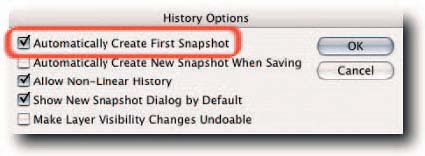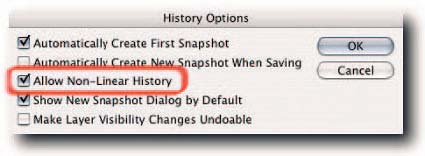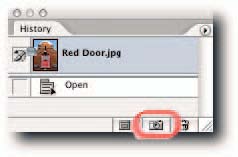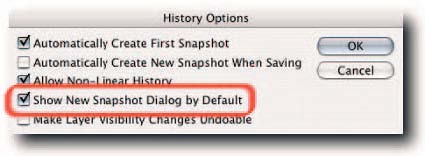Using Palettes – History
As you apply changes to your document, the histories feature creates snapshots and stores them in RAM or on your hard disk that you have assigned as the scratch disk. Each history state is given a name to correspond with the command applied to the document.When the maximum number of history states has been reached, as specified in Preferences>General, in order to make room for the next history state any references to the first history state is erased from the History palette, as well as from memory. However, these snapshots, or history states, are only temporary.When you close the document or quit Photoshop, all history states are erased from memory.
You might ask, what is the point of keeping snapshots of your work in progress? Well, as long as the document is open, its history states can be accessed from the History palette and used as an aid to editing. For example, when you select a history state, the document reverts to that state—not only visually but also with respect to all other properties, such as layers and channels and visibility; these are restored.
You can make use of any one of the available history states to paint from by electing it as the source for the History Brush tool.To give another brief example, you can run the Smart Sharpen filter (Filters>Sharpen>Smart Sharpen) on a layer containing a portrait, select the History Brush tool, elect the previous state—thus undoing the effect of Smart Sharpen—and paint selectively over the eyes, nose, and lips from the Smart Sharpen state. This way, only the areas you paint will take on the sharpening, thus avoiding the sharpening of the skin or hair. You also have control over the opacity of the brush strokes, the blend mode, and, if you employ a pen and tablet, pressure sensitivity.
To make the most of the history feature, here are a few hacks relating to the History palette.
Creating a New Snapshot Automatically
When you open a document, you can force Photoshop to create a snapshot of the current state of the document automatically. This can be a good thing because it will let you revert to the open state should you accidentally perform a save. If you do not create a snapshot, the open history step will be deleted after the maximum number of histories, as specified in Preferences> General, has been exceeded. To create a new snapshot automatically, choose History Options from the History palette menu (Window>History) and then make sure that Automatically Create First Snapshot is selected (Figure 3-21).

FIGURE 3-21: Creating a new snapshot automatically in the History Options dialog box.
Allowing Nonlinear History
By default, new history states are added from the top down: oldest history states at the top and newest at the bottom. If you select a history state, all states that follow are dimmed and then deleted when you apply an edit. The new history state is then appended below the currently selected state. This method allows new histories to be added linearly. However, there is a downside to working in a linear history mode:When you delete a state, all states that follow will also be deleted. If you prefer to hedge your bets and keep all the history states, you can force Photoshop to work in a nonlinear history mode. In this mode, when you select a history state and apply edits to the image, the new state will be added to the bottom of the list and the states that follow the targeted state won’t be deleted. To set nonlinear history mode, choose History Options from the palette menu and then select Allow Non-Linear History (Figure 3-22).

FIGURE 3-22: Specifying nonlinear histories in the History Options dialog box.
Showing New Snapshot Dialog Box Automatically
When you create a new snapshot, if you simply click the “Create new snapshot” icon at the bottom of the palette (Figure 3-23), you are not presented with any options. There are two ways to see the New Snapshot options.
– One, press Alt (Windows), Opt (Mac OS) as you click the Create New Snapshot icon.
– Two, let Photoshop show it automatically each time you click the Create New Snapshot icon.To do so, choose History Options from the palette menu and then select Show New Snapshot Dialog by Default (Figure 3-24).

FIGURE 3-23: The Create New Snapshot icon located at the bottom of the History palette.

FIGURE 3-24: You can tell Photoshop to show the History Options dialog box automatically each time you create a new history snapshot.
Making Layer Visibility Changes Undoable
By default, if you turn layer visibility on/off, it’s not recorded as a history step, which means that you cannot undo the step. Now, you have the option to include layer visibility in the history steps. To turn on the option, choose History Options from the palette menu and then select Make Layer Visibility Changes Undoable (Figure 3-25).

FIGURE 3-25: You can make layer visibility changes undoable in the History Options dialog box.
Purging Histories
Depending on the size of your documents, histories can easily consume a large part of your resources. If you find yourself running low or even on empty, you can:
– Delete all but the topmost history state by choosing Clear History from the palette menu.
– Delete all but the topmost history state by holding down Ctrl (Windows), Ф (Mac OS) and clicking the trash icon.
– Delete single histories by selecting and then clicking the trash icon; hold down Alt (Windows), Opt (Mac OS) if you do not want to verify the command.
– Delete single histories by selecting and then dragging to the trash.
– If you don’t fancy a trip to the History palette, you can choose Edit>Purge> Histories.


Comments